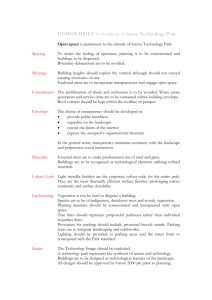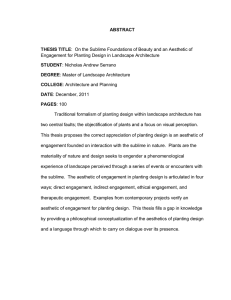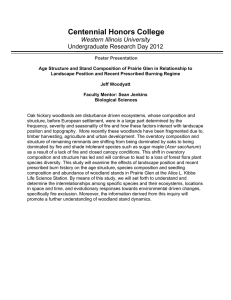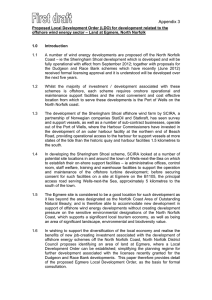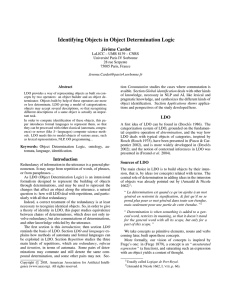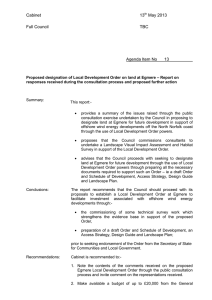Egmere Local Development Order DESIGN CODE
advertisement
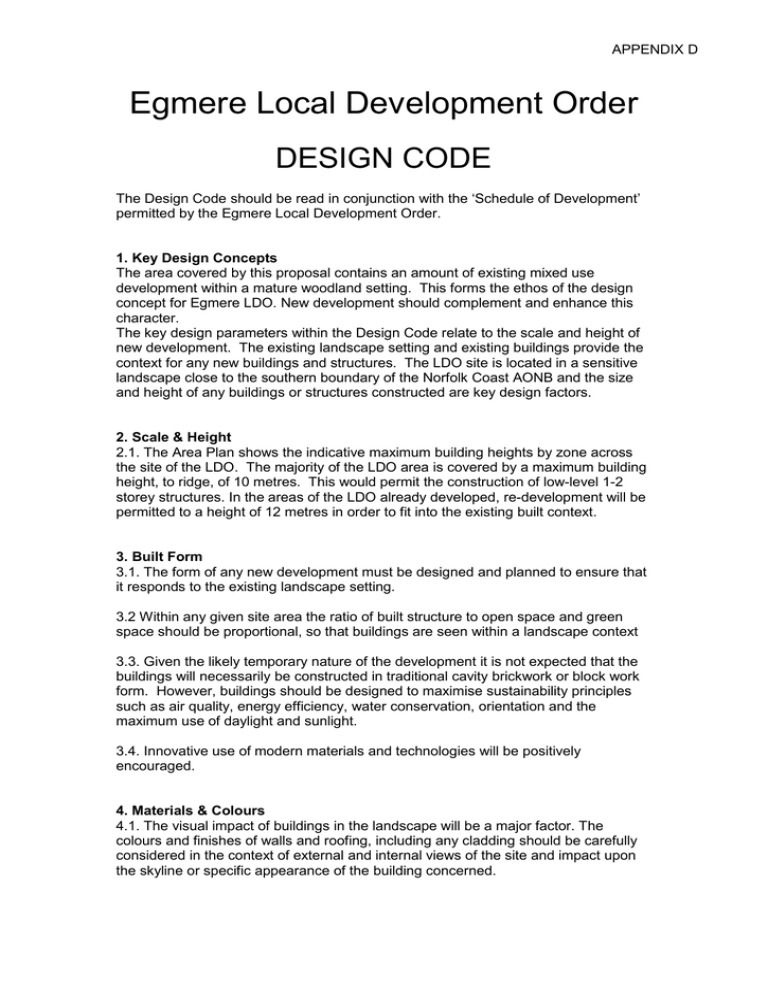
APPENDIX D Egmere Local Development Order DESIGN CODE The Design Code should be read in conjunction with the ‘Schedule of Development’ permitted by the Egmere Local Development Order. 1. Key Design Concepts The area covered by this proposal contains an amount of existing mixed use development within a mature woodland setting. This forms the ethos of the design concept for Egmere LDO. New development should complement and enhance this character. The key design parameters within the Design Code relate to the scale and height of new development. The existing landscape setting and existing buildings provide the context for any new buildings and structures. The LDO site is located in a sensitive landscape close to the southern boundary of the Norfolk Coast AONB and the size and height of any buildings or structures constructed are key design factors. 2. Scale & Height 2.1. The Area Plan shows the indicative maximum building heights by zone across the site of the LDO. The majority of the LDO area is covered by a maximum building height, to ridge, of 10 metres. This would permit the construction of low-level 1-2 storey structures. In the areas of the LDO already developed, re-development will be permitted to a height of 12 metres in order to fit into the existing built context. 3. Built Form 3.1. The form of any new development must be designed and planned to ensure that it responds to the existing landscape setting. 3.2 Within any given site area the ratio of built structure to open space and green space should be proportional, so that buildings are seen within a landscape context 3.3. Given the likely temporary nature of the development it is not expected that the buildings will necessarily be constructed in traditional cavity brickwork or block work form. However, buildings should be designed to maximise sustainability principles such as air quality, energy efficiency, water conservation, orientation and the maximum use of daylight and sunlight. 3.4. Innovative use of modern materials and technologies will be positively encouraged. 4. Materials & Colours 4.1. The visual impact of buildings in the landscape will be a major factor. The colours and finishes of walls and roofing, including any cladding should be carefully considered in the context of external and internal views of the site and impact upon the skyline or specific appearance of the building concerned. APPENDIX D 4.2. Generally, more subdued and non-reflective finishes will reduce the impact of any buildings or structures. Recessive colours for all external facing materials will be required. 4.3 A mixed use of materials is encouraged to give variety to elevations. Timber cladding, composite metal cladding and a buff facing brick to reflect the traditional Holkham gault brick used in the area would all be appropriate. 4.4 Given the elevated position of the site area within its wider context, roof materials should be carefully selected so that they are not dominant in the wider landscape. Recessive matt finishes and green roofs are appropriate solutions. 5. Ancillary Structures 5.1. Structures such as recycling facilities or refuse areas should be integrated into the design of buildings and operative spaces. Siting and appropriate landscaping should ensure that these elements do not dominate the finished scheme . 6. Hard Landscape Proposals 6.1 Surface treatments should incorporate permeable solutions where practicable and avoid extensive use of asphalt. 6.2 Boundary treatments should be suitable for the landscape setting. Close board fencing would not be appropriate in this context. Wire mesh solutions with native hedge& tree planting would be acceptable. 6.3. Details of all boundary fencing and enclosures will be submitted to the LPA for approval prior to installation. 7. Soft Landscape Proposals 7.1. Within the areas of land to be developed a high quality of soft landscape proposals will be required. The layout should include sufficient space between buildings to allow for planted areas that are proportionate to the whole scheme . Parking areas should be broken up with blocks of tree and shrub planting. 7.2 Planting areas should be integral to the SUDS solutions for the site and designed to absorb surface-water run-off. 7.3. The use of native species is appropriate within this rural setting and the planting palette in Appendix 1 reflects this. Further advice on appropriate plant species, grouping and densities should be sought from the Council’s Landscape Officer. 7.4 Mixed native hedge planting should be used to soften boundary features such as security fencing. This should be planted in a double staggered row at a ratio of 5 plants per metre. 8. Landscape Maintenance 8.1 Appropriate establishment measures for all planted areas and a programme of regular management during the period of the LDO will be an essential component of any proposal. APPENDIX D 9. Biodiversity 9.1. Development taking place within the LDO must have regard to the potential presence of protected species and make provision accordingly. This includes a requirement for appropriate survey information, mitigation and compensation. 10. Drainage 10.1 Sustainable drainage solutions should be integral to the site design and comply with current SUDS requirements. Components should address the treatment of onsite attenuation and include multi-functional features such as swales, permeable paving and appropriate planting. 11. Car Parking & Access 11.1. On-site car parking provision within the LDO will comply with the standards contained in Appendix C of the North Norfolk LDF Core Strategy. All access roads and visibility splays should be agreed with the Highways Authority. For office and industrial use one parking space per 30 sq. metres of floor space is required. 12. Lighting 12.1 Details of all required external lighting should be submitted to the LPA for approval prior to installation. Directed lighting, use of PIR, low level lighting, avoidance of lighting reflective surfaces are all appropriate features and should be designed to minimise light pollution and avoid natural linear features used by commuting nocturnal wildlife . 13. Noise 13.1 Developers should seek to minimise the potential for noise pollution from the intended activities and to incorporate appropriate noise attenuation measures into the building design. 13.2 Particular attention should be given to the attenuation of noise where 24 hour operations are expected. 13.3 Consideration should be given to the potential impact of audible hazard warnings on reversing vehicles, alarms and other mechanical equipment. 14. Signs & Advertisements 14.1. Entrance signs and notices should be suitably designed to respect the rural nature of the location and should not exceed the parameters contained with the appropriate regulations. 14.2. Signs that do not require consent should be designed to have limited local impact. 14.3 Permission will be required for any luminated signage. 15. Archaeology & Heritage Assets 15.1. The LDO is located on the site or in the vicinity of the former RAF North Creake Airfield and there are a substantial number of World War II buildings and structures still present. In addition there is evidence of Anglo-Saxon settlement nearby. APPENDIX D 15.2. Within the existing developed areas, either side of the B1105 any removal of buildings or structures should normally be avoided. However, if re-development in these areas is being considered it is a requirement that all structures be recorded and their archaeological significance identified by a recognised Archaeological Service such as the Norfolk Historic Environmental Service. 16. Renewable Energy & Other Miscellaneous Design Criteria 16.1. The LDO Schedule specifies the maximum height for masts, aerials and antennae (25m). The use of roof-mounted photovoltaic panels is encouraged so long as issues of glare and reflection that may affect long range views are minimised. Review of LDO The LDO and the Design Code will be reviewed and amended at regular intervals and at periods of no longer than 5 years apart. APPENDIX D LDO Egmere Proposed Planting Palette 1.0 STRUCTURAL PLANTING Main Woodland Mix Name Species Height %mix Austrian Pine Scots Pine English Oak Holm Oak Silver Birch Field maple Pinus nigra Pinus sylvestris Quercus robur Quercus ilex Betula pendula Acer campestre 90-120 90-120 90-120 90-120 90-120 90-120 10 10 30 30 10 10 2 Plant whips of between 60-120cm height at 1.5/m for woodland, including 20% 2.0-2.5m feathered trees. Woodland to be planted with an understorey mix comprising holly, hazel, wild cherry, blackthorn, guelder rose . Native, indigenous plants of local provenance should be used where available Woodland Edge Mix Name Species Height %mix Field Maple Crab Apple Guelder rose Hazel Holly Hawthorn Gorse Acer campestre Malus sylvestris Viburnum opulus Corylus avellana Ilex aquifolium Crataegus monogyna Ulex europaeus 40-60 40-60 40-60 40-60 40-60 40-60 40-60 20 15 10 5 15 30 5 Plant species in groups of 5 or 7 @ 1m centres Depth of edge mix to vary between 4 – 6m New Hedge planting should be in a double staggered row with 45cm between rows @ 30-45cm spacings. Field Margin A 6m ungrazed field margin should be maintained adjacent to the woodland edge to provide a foraging and commuting habitat and to promote biodiversity in line with Natural England’s Entry Level Stewardship Guidelines. This zone should be cut once every 3-5 years to prevent the establishment of scrub. APPENDIX D 2.0 SITE SPECIFIC PLANTING Trees As well as reflecting the species choice for the structural planting, additional species could include Whitebeam Wild service tree Crab apple Hornbeam Grey alder Silver Birch Bird Cherry Sorbus intermedia Sorbus torminalis Malus sylvestris Carpinus betulus Alnus incana Betula pendula Prunus padus Shrubs Species choice could include the following native plants: Barberry Berberis sp. Butterfly bush Buddleia davidii Hazel Corylus avellana Dogwood Cornus sanguinea Dogwood Cornus alba Aurea Currant Ribes alpinum Oregon grape Mahonia aquifolium Guelder rose Viburnum opulus Buckthorn Hippophae rhamnoides Snowy mespilus Amelanchier lamarkii Pheasant berry Leycesteria formosa Yew Taxus baccata Privet Ligustrum vulgare Alder buckthorn Frangula alnus Spindle Euonymus europaeus Hedges Hedgerow mixes could include the following native and evergreen species: Hawthorn Crataegus monogyna Blackthorn Prunus spinosa Holly Ilex aquifolium Hazel Corylus avellana Dog rose Rosa canina Privet Ligustrum vulgare Field maple Acer campestre Yew Taxus baccata
